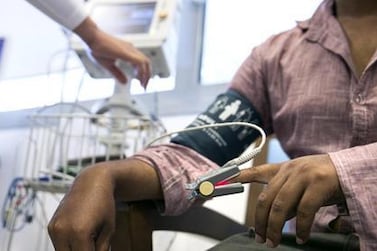Young people are becoming more at risk from diabetes and inactive people are twice as likely to suffer from the condition, according to the latest Dubai household health survey.
Results from the door-to-door questionnaire conducted by Dubai Health Authority found 30 per cent of the Emirate’s population was either diabetic, or pre-diabetic.
While the overall rates were similar to the previous analysis in 2017, the latest data showed slightly fewer residents had diabetes but that was balanced out by those likely to develop the condition in future.
The total number of survey respondents was not revealed.
The research was the third such population study in Dubai, with 13 per cent of residents aged 25-45 showing early diabetes markers, prompting doctors to call for younger people to be screened.
“Increasing physical activity seems to be a simple and very effective method of reducing the prevalence of diabetes especially in the prediabetes group, which is a significant percentage,” said Dr Fatheya Al Awadi, an endocrinologist at Dubai Hospital who heads the DHA’s Diabetes Committee.
“This study reinforces the importance of lifestyle modification and highlights clearly that regular physical activity coupled with a healthy eating pattern can help prevent those with prediabetes from developing the condition.”
Just five per cent of those surveyed did intense physical activity such as running or playing football for ten minutes continuously, with 17 per cent completing daily moderate exercise for at least 10 minutes.
Of those asked, 18 per cent completed exercise routines between one and three times a week.
Researchers concluded 20 per cent of inactive Emiratis in Dubai had diabetes, but this was halved if they completed regular exercise.
Obesity and smoking were strongly linked to the illness.
In those with a normal, healthy weight just 7.5 per cent were diabetic, but that figure almost trebled to 21.5 per cent in those who were obese.
The study revealed in Emiratis who smoked, 28 per cent had diabetes, compared with 14.5 per cent who did not.
While in expatriates, diabetes was present in one in 10 smokers and 6.3 per cent of non-smokers.
“The aim of the study was to better understand diabetes prevalence and risk factors in Dubai,” said Khalid Jallaf, director of the DHA’s Data Analysis, Research & Studies Department.
“We’ve done this by assessing incidence rates, identifying the risk factors and demographic distribution of the most vulnerable to the disease.”
Age was considered a major factor in how common the condition was in Dubai.
In those aged 18-24, just 2.9 per cent were diagnosed but that number soared to 43.7 per cent in the over 60s.
The survey was completed in partnership with the Dubai Statistics Centre and included in-depth analysis of the prevalence, status and risk factors.
Further research is underway in collaboration between DHA and New York University Abu Dhabi to understand the impact of the disease on the national Emirati population.
Researchers are seeking thousands of Emiratis to participate in a study that will help them to understand the reasons behind the high levels of diabetes and obesity in the country.
Dr Mohammed Hassanein, senior consultant endocrinologist at Dubai Hospital and a member of the DHA Diabetes Committee, said the latest household figures rubber-stamped the importance of a healthy lifestyle to keep chronic illness at bay.
“The study greatly reinforces the importance of a well-structured plan to prevent diabetes that includes regular exercise and weight loss,” he said.
“It is imperative for community members to individually look into their daily routine and see how they can add consistent healthy habits that will prevent them developing chronic lifestyle diseases.”







